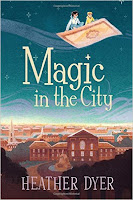The children in these books would leave the ordinary world behind and enter a new reality each time the the wishing chair grew wings, or each time they climbed into the worlds at the top of the Faraway Tree. So the chair and the tree were the perfect vehicles for linking separate, self-contained adventures.
An episodic book is ideal for bedtime reading because the action builds quickly and each adventure comes to a natural close - but there's another adventure to look forward to the following night. So an episodic book offers several crescendos within one book, rather like dirt jumping with your mountain bike rather than cycling up a mountain.
Magic seems to lend itself to episodic storytelling, perhaps because magic can change the known world so swiftly and dramatically. Magic is also versatile and unpredictable, and when it stops the world order is swiftly and reassuringly restored. All these factors seem to contribute to vertiginous peaks and troughs.
But episodic books aren’t just for bedtime, or for readers without stamina. By the age of 8 I was a voracious reader and the books that gave me most enjoyment were still episodic. Edith Nesbit does episodic magic particularly well.
In Five Children and It, Cyril, Anthea, Robert, and Jane find a sand fairy, the Psammead, who grants them different wishes. Each adventure allows the author to explore what would happen when a different child 'gets what they wished for'. A new adventure can be a seamless opportunity to change the point-of-view character and show the reader what's going on in different characters' heads. It also allows the author to explore dynamics between characters from different perspectives.
Cyril, Anthea, Robert, and Jane reappeared in The Phoenix and the Carpet, and when I had finished the last page I remember weeping – not because the story ended sadly, but because my time with the children was over.
But an episodic children’s book isn’t (or shouldn’t be) just a series of thrills. The mini-adventures themselves need to be embedded within an overarching narrative that ties all the episodes together. As in any story (and in life) what characters want may not be what they really need. Characters are often flawed or damaged, and this makes them misguided. Each episode must provide an opportunity to explore these issues a little more deeply, building the overall tension and bringing things to a head – before resolving them.
I had to wait a couple of years to discover Diana Wynne Jones, a more contemporary author who, in The Ogre Downstairs, writes about step-siblings who are given magical chemistry sets that allow them to fly, shrink, or become invisible. Here, the children have been thrown together in the same house when their single parents decide to move in together. So, as a backdrop to the exciting adventures, a story about sibling rivalry, domestic disharmony and family dynamics develops.
As with any story worth its salt, in an episodic adventure characters change and develop, lessons are learned, and 'false beliefs' are exposed. Most importantly, the reader needs to feel that the adventures won't end when the book is closed, and that the characters will continue to live and grow, despite - or because of - the bumps along the way. After all, that’s what we want for ourselves, isn’t it? And that, I believe, is the message behind the shape of all stories.











6 comments:
Children still enjoy episodic books, I think. Not to mention series books. :)
The Wizardry Of Jewish Women - The New Edition
An excellent point and analysis, Heather.
I'm pleased to hear it! ☺️
Thanks Penny
Excellent post, Heather. Many thanks.
Post a Comment